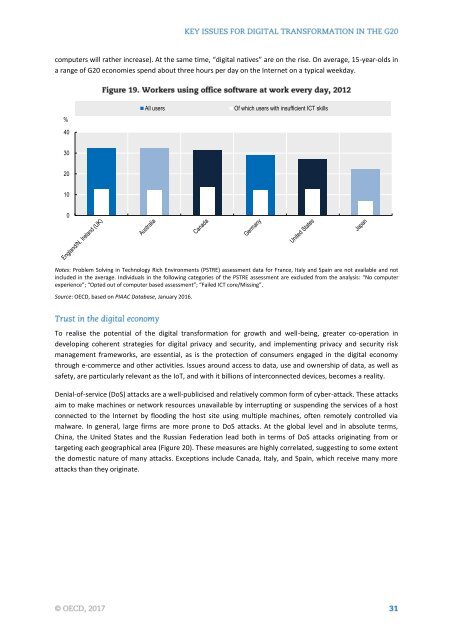KEY ISSUES FOR DIGITAL TRANSFORMATION IN THE G20
2jz0oUm
2jz0oUm
Create successful ePaper yourself
Turn your PDF publications into a flip-book with our unique Google optimized e-Paper software.
computers will rather increase). At the same time, “digital natives” are on the rise. On average, 15-year-olds in<br />
a range of <strong>G20</strong> economies spend about three hours per day on the Internet on a typical weekday.<br />
%<br />
40<br />
All users<br />
Of which users with insufficient ICT skills<br />
30<br />
20<br />
10<br />
0<br />
Notes: Problem Solving in Technology Rich Environments (PSTRE) assessment data for France, Italy and Spain are not available and not<br />
included in the average. Individuals in the following categories of the PSTRE assessment are excluded from the analysis: “No computer<br />
experience”; “Opted out of computer based assessment”; “Failed ICT core/Missing”.<br />
Source: OECD, based on PIAAC Database, January 2016.<br />
To realise the potential of the digital transformation for growth and well-being, greater co-operation in<br />
developing coherent strategies for digital privacy and security, and implementing privacy and security risk<br />
management frameworks, are essential, as is the protection of consumers engaged in the digital economy<br />
through e-commerce and other activities. Issues around access to data, use and ownership of data, as well as<br />
safety, are particularly relevant as the IoT, and with it billions of interconnected devices, becomes a reality.<br />
Denial-of-service (DoS) attacks are a well-publicised and relatively common form of cyber-attack. These attacks<br />
aim to make machines or network resources unavailable by interrupting or suspending the services of a host<br />
connected to the Internet by flooding the host site using multiple machines, often remotely controlled via<br />
malware. In general, large firms are more prone to DoS attacks. At the global level and in absolute terms,<br />
China, the United States and the Russian Federation lead both in terms of DoS attacks originating from or<br />
targeting each geographical area (Figure 20). These measures are highly correlated, suggesting to some extent<br />
the domestic nature of many attacks. Exceptions include Canada, Italy, and Spain, which receive many more<br />
attacks than they originate.


